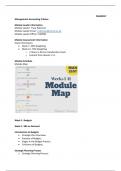Class notes
MAN2017 Management Accounting 2
- Course
- Institution
A comprehensive document containing all of the relevant information pertaining to the weekly SBS on Demand videos, weekly seminar questions, weekly seminars, weekly lectures, exam insight and further reading.
[Show more]



